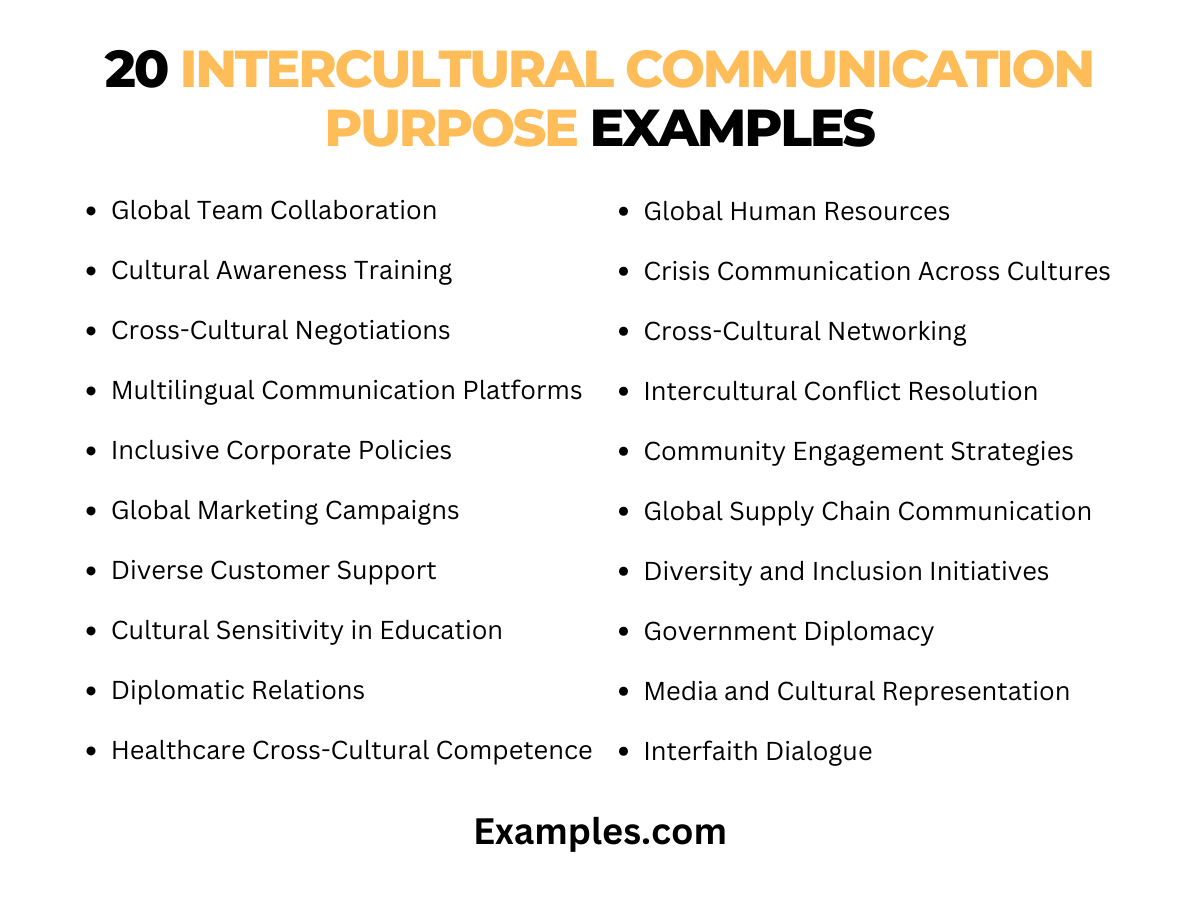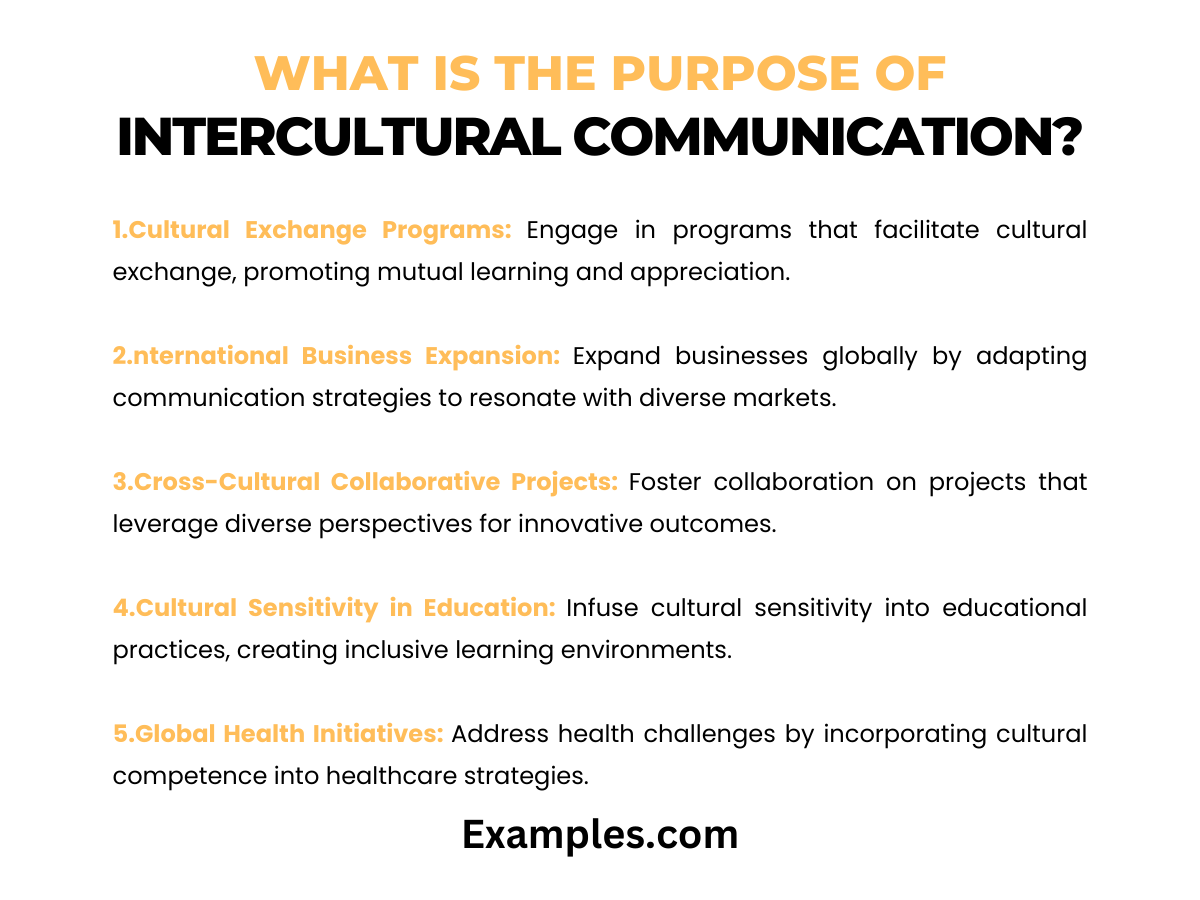19+ Intercultural Communication Purpose Examples
Embark on a transformative journey with our complete guide to Intercultural Communication Purpose. 🌐 Uncover the profound significance of cultural exchange through insightful examples, actionable strategies, and expert insights. Learn how to navigate diverse landscapes with finesse, enhancing your communication skills and fostering global connections. This guide transcends theory, providing practical tips and real-world communication examples to elevate your cultural intelligence and enrich cross-cultural experiences. Embrace the power of purposeful intercultural communication in an interconnected world.
20 Intercultural Communication Purpose Examples
Explore 20 dynamic Intercultural Communication Purpose examples, delving into the intricate tapestry of global interaction. Uncover valuable insights, actionable strategies, and real-world scenarios to amplify your cultural intelligence. Navigate cross-cultural landscapes with finesse, enriching your communication skills for a connected world.

- Global Team Collaboration: Effectively communicate goals and expectations across diverse teams, fostering unity.
- Example: Clarify project objectives in a culturally inclusive manner to ensure shared understanding.
- Cultural Awareness Training: Implement programs to enhance cultural understanding and bridge communication gaps.
- Example: Conduct workshops on cultural nuances to promote respectful dialogue among team members.
- Cross-Cultural Negotiations: Navigate negotiations with awareness, addressing cultural differences for successful outcomes.
- Example: Employ active listening and adapt communication styles when negotiating international business deals.
- Multilingual Communication Platforms: Embrace diverse languages for seamless communication in multilingual environments.
- Example: Utilize translation tools for effective communication across language barriers in virtual meetings.
- Inclusive Corporate Policies: Develop policies that prioritize inclusivity, promoting cultural understanding within the workplace.
- Example: Establish inclusive language guidelines to foster a diverse and respectful organizational culture.
- Global Marketing Campaigns: Tailor marketing messages to resonate with diverse cultural audiences, ensuring relevance.
- Example: Adjust visuals, messaging, and tone to align with cultural preferences in international marketing efforts.
- Diverse Customer Support: Provide culturally sensitive customer support, addressing unique needs and preferences.
- Example: Train customer service teams to recognize and adapt to cultural differences in communication styles.
- Cultural Sensitivity in Education: Incorporate diverse perspectives and teaching methods to cater to varied cultural backgrounds.
- Example: Develop curriculum materials that reflect cultural diversity, enhancing student engagement and understanding.
- Diplomatic Relations: Foster positive diplomatic relations by respecting cultural norms and customs in international negotiations.
- Example: Navigate political discussions with cultural sensitivity, acknowledging diverse perspectives.
- Healthcare Cross-Cultural Competence: Train healthcare professionals to provide culturally competent care, respecting diverse patient backgrounds.
- Example: Conduct cultural competency workshops for medical staff to enhance communication with patients from different cultures.
- Global Human Resources: Develop HR practices that acknowledge and celebrate cultural diversity within the workforce.
- Example: Implement inclusive recruitment strategies, recognizing diverse talents and experiences.
- Crisis Communication Across Cultures: Navigate crises with cultural awareness, addressing concerns and providing reassurance.
- Example: Craft crisis communication plans that consider cultural sensitivities and communication preferences.
- Cross-Cultural Networking: Build strong professional networks by embracing diverse communication styles in global business events.
- Example: Attend international conferences and adapt communication approaches to establish meaningful connections.
- Intercultural Conflict Resolution: Resolve conflicts by acknowledging cultural differences and finding mutually acceptable solutions.
- Example: Mediate disputes with a focus on understanding diverse perspectives to reach resolutions amicably.
- Community Engagement Strategies: Develop outreach programs that consider cultural contexts, fostering community involvement.
- Example: Organize culturally relevant events to engage diverse community members and promote inclusivity.
- Global Supply Chain Communication: Enhance communication across international supply chains, considering cultural logistics.
- Example: Coordinate logistics with suppliers from various cultural backgrounds, ensuring smooth operations.
- Diversity and Inclusion Initiatives: Implement initiatives that go beyond representation, fostering genuine inclusion and equity.
- Example: Establish Employee Resource Groups that celebrate cultural diversity, providing a platform for shared experiences.
- Government Diplomacy: Strengthen diplomatic ties by employing culturally sensitive communication in international relations.
- Example: Negotiate treaties with respect for cultural nuances, promoting mutual understanding and cooperation.
- Media and Cultural Representation: Promote diverse cultural narratives in media, contributing to global understanding.
- Example: Create content that challenges stereotypes and showcases diverse cultural perspectives in mainstream media.
- Interfaith Dialogue: Facilitate respectful conversations among individuals of different faiths, fostering understanding.
- Example: Organize interfaith forums that encourage open dialogue, promoting harmony and cultural appreciation.
Intercultural Communication Purpose in Healthcare
Enhance patient care with our guide to Intercultural Communication Purpose in Healthcare. Explore the vital role of cultural sensitivity in medical settings, with real-world examples and strategies to improve doctor-patient relationships. Elevate healthcare experiences by embracing diverse perspectives and fostering inclusive communication.
- Multilingual Patient Consultations: Effectively communicate medical information by offering translation services and accommodating language preferences.
- Culturally Tailored Health Education: Develop educational materials that resonate with diverse cultural backgrounds, promoting health literacy.
- Ethical Decision-Making Across Cultures: Navigate ethical dilemmas by considering cultural nuances, ensuring culturally competent care.
- Inclusive Medical Staff Training: Conduct training programs to equip healthcare professionals with intercultural communication skills for diverse patient interactions.
- Cross-Cultural Mental Health Support: Provide mental health services that recognize and respect cultural beliefs, fostering trust and understanding.
Intercultural Communication Purpose in the Workplace
Unlock the potential of diverse workplaces with our guide to Intercultural Communication Purpose in the Workplace. Navigate multicultural dynamics, fostering collaboration and inclusive communication. Learn strategies to bridge cultural gaps, enhance teamwork, and create a harmonious and productive work environment.
- Cross-Cultural Team Building: Organize team-building activities that celebrate diverse cultures, promoting unity and camaraderie.
- Effective Communication in Virtual Teams: Establish clear communication protocols for virtual teams, considering cultural nuances for seamless collaboration.
- Cultural Competence Training for Employees: Offer training sessions to enhance employees’ cultural competence, fostering a culturally aware workforce.
- Inclusive Leadership Styles: Adopt leadership styles that consider cultural diversity, promoting inclusivity and employee engagement.
- Diverse Recruitment Practices: Implement recruitment strategies that attract talent from various cultural backgrounds, ensuring a diverse workforce.
What Is The Purpose of Intercultural Communication
Embark on a transformative exploration of the multifaceted purpose of intercultural communication. Learn how this dynamic practice fosters understanding, harmony, and collaboration across diverse global contexts. Discover actionable insights, real-world examples, and expert strategies to navigate the intricacies of cross-cultural interactions. Elevate your communication skills and contribute to a connected world where cultural diversity is not just acknowledged but celebrated.

- Cultural Exchange Programs: Engage in programs that facilitate cultural exchange, promoting mutual learning and appreciation.
- International Business Expansion: Expand businesses globally by adapting communication strategies to resonate with diverse markets.
- Cross-Cultural Collaborative Projects: Foster collaboration on projects that leverage diverse perspectives for innovative outcomes.
- Cultural Sensitivity in Education: Infuse cultural sensitivity into educational practices, creating inclusive learning environments.
- Global Health Initiatives: Address health challenges by incorporating cultural competence into healthcare strategies.
- Cross-Cultural Friendship Building: Cultivate meaningful friendships across cultures, fostering personal growth and global understanding.
- Diverse Social Events: Organize events that celebrate cultural diversity, encouraging cross-cultural interactions.
- Inclusive Language Policies: Implement language policies that respect linguistic diversity within organizations.
- Humanitarian Aid Across Borders: Provide humanitarian aid that considers cultural contexts and sensitivities.
- Global Environmental Sustainability: Collaborate on environmental initiatives that respect cultural practices and ecological awareness.
In conclusion, this guide illuminates the transformative purpose of intercultural communication. By embracing diverse examples, actionable strategies, and expert insights, it unveils the power to foster global understanding and connections. Armed with cultural intelligence, readers are equipped to navigate cross-cultural scenarios, celebrate diversity, and contribute to a more interconnected and harmonious world.



